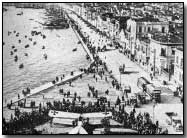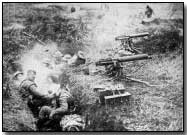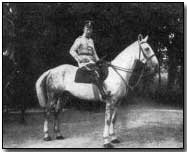Memoirs & Diaries - The Carnoy Cows
 Both boots had been worn
thin at the heel. They were also plashed heavily with mud. Slimy,
grey, limestone mud. The puttees, too, were mud stained and the khaki
pants, but it was the boots that fascinated me.
Both boots had been worn
thin at the heel. They were also plashed heavily with mud. Slimy,
grey, limestone mud. The puttees, too, were mud stained and the khaki
pants, but it was the boots that fascinated me.
I had been watching those two boots moving up and down throughout the whole of a bleak winter's afternoon. There were hundreds of other boots - my own included - all moving up and down, but only the two directly in front really mattered.
Left-right, left-right, on they went till the sun went down and the sticky surface of the road turned crisp with frost. The down-at-heel boots continued to plod onwards. Darkness came on apace and mercifully hid them from view.
Stars were shining in a clear sky when we halted, tired out and hungry, by the grey-stoned church of Bray-sur-Somme. At last we had arrived at our destination. The battalion had been marching for several days. We were about to experience our first taste of trench warfare in a "quiet spot," and Bray was to be our headquarters when out of the line.
We were to journey up to the trenches under cover of darkness on the following night. The orderly sergeant broke the news when he came to our billet with Battalion Orders. Nobody seemed to care. We were too weary and foot-sore to take much notice.
"Can anyone here milk a cow?" It was the sergeant speaking, but no reply to this strange question was forthcoming. If he had asked for a volunteer to kill a pig, the request could not have been more unexpected. The next moment, however, my elbow was nudged. "Go on, chum. Speak up. There's a soft job for you!"
"Can you milk a cow?" said the sergeant, eyeing me suspiciously. I nodded my head. "Then in future you will be attached to Headquarters' Company. Tomorrow you will parade at 3.30 a.m. to march with the advance party for the trenches." Without any further word of explanation, the sergeant turned and walked through the doorway, out into the darkness of the deserted village street.
What in the name of goodness had I let myself in for now? Weary with foot-slogging, I had hoped for at least a day's rest before going up the line. But, no. Long before dawn I was to be on the road once more. Cursing my luck, I turned in for a few hours' sleep before turning out again.
There is little need to dwell upon the discomforts of the following morning. The early rise in the dark and the parade of Headquarters' Company in the keen, frosty air. "Is the cowman there? Right." Off we trudged along the road to the trenches.
 In the grey light of early
dawn we found ourselves looking down on a few shell-shattered rooftops - all
that was left of Carnoy. Marching downhill, we halted amongst the
ruins just as the rattle of a machine gun and desultory rifle-fire told us
that it was "stand-to" in the trenches.
In the grey light of early
dawn we found ourselves looking down on a few shell-shattered rooftops - all
that was left of Carnoy. Marching downhill, we halted amongst the
ruins just as the rattle of a machine gun and desultory rifle-fire told us
that it was "stand-to" in the trenches.
Carnoy was Battalion Headquarters for the troops holding the line. On one side of the road was the colonel's dug-out. Opposite were the remains of a farmstead and near by a communication trench labelled Montauban Alley. Here amid the tumble-down debris of bricks and mortar I was to find a home. I was also to find my new job waiting for me.
"Is the cowman there?" asked a sleepy voice. "Come on, chum. Follow me. I'll show you what kind of a job you've been let in for!" The speaker had evidently just emerged from beneath his blanket. I followed him between two buildings where once there had been a gateway.
The gateway had belonged to the farmyard which had been square in shape, a large midden in the centre and out-buildings all round. The midden was still there. No cows, no horses, no pigs were to be seen. Not even a barn-door fowl. The buildings were in ruins and a death-like silence seemed to brood over the whole place.
"Here we are," said my sleepy companion as we clattered over the cobblestones and halted in front of the only building with any semblance of a roof. Somewhere in the darkness beyond the open doorway there was a movement which produced a faint rustling noise. There was no mistaking that familiar sound. It was the swish of a cow's tail.
There were two cows - one dry and the other giving a bare quart of milk, I was told. The milk was to be taken to the colonel's dug-out. "What do the poor beggars live on?" was my first question. "I'll show you after breakfast," was the reply. I was content to wait, for up the steps of a nearby dugout came the savoury smell of fried bacon.
The dugout was deep and down below it was comfortably warm and dry. Sore feet and aching shoulders were forgotten as we gathered round the fire to enjoy a drink of piping hot tea.
 Breakfast finished, we
returned to our charges once more. Undoing the tethering ropes, we led
the cows out of the farmyard and along the roadway to a piece of waste land
behind the colonel's dug-out. Here we fastened them to two long ropes
which were pegged into the ground. "That's all they get to eat," said
my companion, and he pointed to the withered, brown grass which grew between
the shell holes. "If it doesn't fatten it'll fill," he remarked, and
with that we left the poor beasts grazing peacefully.
Breakfast finished, we
returned to our charges once more. Undoing the tethering ropes, we led
the cows out of the farmyard and along the roadway to a piece of waste land
behind the colonel's dug-out. Here we fastened them to two long ropes
which were pegged into the ground. "That's all they get to eat," said
my companion, and he pointed to the withered, brown grass which grew between
the shell holes. "If it doesn't fatten it'll fill," he remarked, and
with that we left the poor beasts grazing peacefully.
Back once more in the farmyard we made our way across to the far side of the ruins, where a layer of ice glistened on the surface of a waterlogged shell hole. Here lay the main source of our water supply for the cows. But one had to be careful, for the spot was overlooked from the enemy's trenches. "Keep your head down. That bloomin' sniper ain't a bad shot." With these words I received final instructions for my newly acquired job as the colonel's cowman.
That night, while I lay snug and warm in the farmyard dugout, my old platoon marched up Montauban Alley on their way to the front line. My thoughts went with them. I visualized the cold, clammy, trench mud, the lonely night-watch on the fire-step and all the discomforts of trench life. After all, that parade with Headquarters' Company at 3.30 a.m. had been worth while!
One morning, as I sat milking, a tabby cat wandered in through the doorway of the old cowshed. She mewed plaintively. The poor creature was nothing but a walking bag of bones. How on earth she got any food in this deserted place it was difficult to imagine. When I endeavoured to stroke her, she drew back, spitting savagely. However, a drop of milk in an old tin worked wonders and soon she became quite tame and confiding.
Often a skylark sang sweetly when I went to tether the cows on their scanty pasture amongst the shell holes. Apparently the birds were unaffected by the firing. At times a kestrel hawk could be seen hovering over the desolate wastes that had once been fields. Then there was a thrush that called from the shattered branch of a roadside tree. Men might die, cities, towns, and villages might fall in ruin, but still the birds sang on!
At night-time I discovered that the farmyard was by no means deserted. Standing there in the bright moonlight, the scene was a grim one, with black ruins silhouetted against a starlit sky. In the centre of the yard the midden was alive with small, moving forms. Twin pairs of glittering eyes were watching in the shadows and high-pitched squeaky calls came from every corner. Rats. They were everywhere! They gambolled over the midden, fought with each other on the cobblestones, and went scavenging in parties through the gloom of the tumbledown buildings.
 As I stood watching this
strange spectacle a dark shadow passed over the moonlit ruins. This
was followed by a sudden and shrill scream of pain from the far side of the
yard. Descending on silent wings, a great white barn owl had snatched
up a victim. A wild scurry for cover and the yard was deserted. But
not for long.
As I stood watching this
strange spectacle a dark shadow passed over the moonlit ruins. This
was followed by a sudden and shrill scream of pain from the far side of the
yard. Descending on silent wings, a great white barn owl had snatched
up a victim. A wild scurry for cover and the yard was deserted. But
not for long.
In a very few minutes the hordes of rats were back once more at their nightly revels. Looking back on those far-off days in the early spring of 1916 it seems difficult to realize that we used to keep cows in the trenches. Few survivors of those who were plunged into the terrible fighting on the Somme would find it possible to believe that the colonel in charge of the Carnoy sector had fresh milk for his breakfast every morning!
But then in those days the Somme was looked upon more or less as a picnic. Apart from one or two references in the papers to the leaning virgin of Albert, or the statement that another mine had gone up at Fricourt, there was little publicity given to these parts. Trones Wood, Delville Wood, Mametz, Guillemont and a hundred other historic place names were, of course, unheard of before the big push.
My job as colonel's cowman was a pleasant occupation compared to life in the front line. Once, when we attempted to increase the cows' milk yield and the C.O. demanded that hay should be sent up the line, I got into the Transport Officer's bad books for stealing his clover! Otherwise there were few happenings of note. A shell or two now and then and that damned sniper for ever trying to knock the last remaining scrap of plaster off the farm buildings. That was about all.
For nearly two months the battalion journeyed backwards and forwards between Bray and the Carnoy sector. But at length there came rumours of a move. We were going to take over another lot of trenches on the right. This meant, of course, that our headquarters would no longer be at Carnoy. It also meant that our colonel would no longer have fresh milk for his breakfast!
We are told that all good things come to an end sooner or later. I myself could not grumble, for the cowman's job had saved me many hours of tedious fire-step duty in the front line. We were resting at Bray when news of the move came through, and with it came orders for the colonel's cowman to be returned to his old company.
 I
saw no more of the Carnoy cows and can't even say what happened to them.
It may be that the German sniper put an end to their precarious existence,
or perhaps they were killed in that tornado of shell-fire which heralded the
Somme attack.
I
saw no more of the Carnoy cows and can't even say what happened to them.
It may be that the German sniper put an end to their precarious existence,
or perhaps they were killed in that tornado of shell-fire which heralded the
Somme attack.
On the other hand, it is quite possible that they may have lived on to greet the astonished eyes of the old farmer when he returned to his ruined village.
Private T. S. Williams served in 19th Battalion King's Liverpool Regt., 89th Brigade, 30th Division, from 1914 to 1918, on the Western Front.
First published in Everyman at War (1930), edited by C. B. Purdom.
Photographs courtesy of Photos of the Great War website.
Duck-Boards comprised slatted wooden planking used for flooring trenches or muddy ground.
- Did you know?
